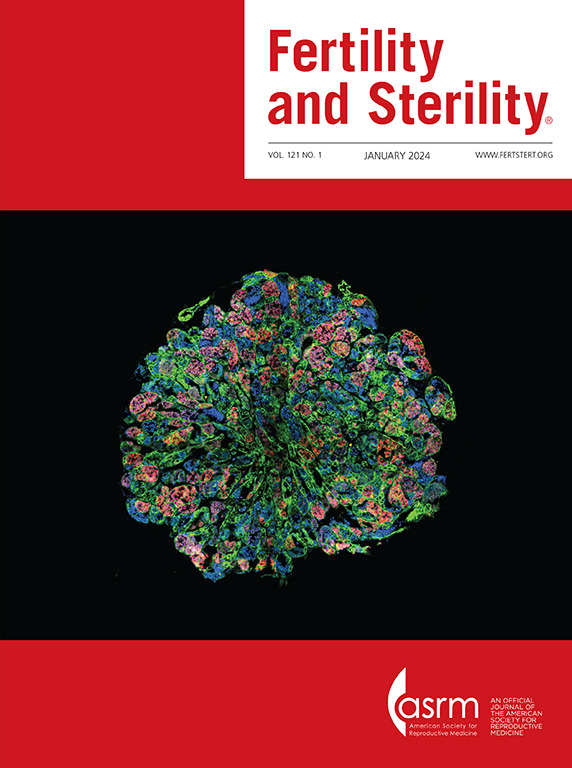IMPACT OF BILATERAL INTRAOVARIAN PLATELET-RICH PLASMA IN WOMEN WITH POOR OVARIAN RESPONSE OR PRIMARY OVARIAN INSUFFICIENCY. A RETROSPECTIVE STUDY.
IF 6.6
1区 医学
Q1 OBSTETRICS & GYNECOLOGY
引用次数: 0
Abstract
OBJECTIVE To investigate the association of autologous platelet-rich plasma (PRP) treatment with functional ovarian reserve parameters and in vitro fertilization outcomes of poor ovarian responders and women with primary ovarian insufficiency (POI) who refused oocyte donation. DESIGN Observational, retrospective, multicentric cohort study SUBJECTS: Three hundred and fifty-three women who underwent PRP treatment, including 207 poor responders and 146 diagnosed with POI. EXPOSURE Intraovarian PRP injection. MAIN OUTCOME MEASURES Main outcomes were Antral follicular counts (AFC) and serum anti-müllerian hormone (AMH). Secondary outcomes were in vitro fertilization parameters, and reproductive outcomes. RESULTS In the poor responders cohort (40.0±3.8 years old, AMH0=0.43±0.54 ng/mL; AFC0=2.6±2.4), intraovarian PRP was associated with significantly improved AFCs at each follow-up visit (AFC0=2.6±2.4 vs. AFC1=5.3±3.6; AFC2=4.5±3.5; AFC3=4.0±2.4; AFC4=3.6±2.7; p<0.01 for all comparisons) compared to the pretreatment levels. There were 100 pretreatment, and 231 posttreatment ovarian stimulation cycles initiated in 111 poor responders with similar yields of MII oocytes (Pre-PRP:2.4±3.0 vs. Post-PRP:3.0±3.4, p=0.12) and blastocysts obtained (Pre-PRP:0.5±0.7 vs. Post-PRP:0.6±1.1, p=0.17). However, we found novel positive associations between PRP and oocyte quality-related parameters such as maturation (Pre-PRP:65.8% vs. Post-PRP:80.8%, p=0.003) and fertilization rates (Pre-PRP:61.6% vs. Post-PRP:75.8%, p=0.011), although statistically significant differences were not reached for implantation (Pre-PRP:9.4% vs. Post-PRP:35.1%, p=0.07), and biochemical pregnancy rates (Pre-PRP:12.5% vs. Post-PRP:41.5%, p=0.07). We identified 23 clinical pregnancies (17 after embryo transfer and six natural conceptions) with seven live births in poor responders who received PRP. In the POI cohort (38.7±4.3 years old, AMH0 = 0.1±0.1 ng/mL; AFC0= 1±1.2), PRP treatment was only related to higher AFCs (AFC1 = 2.1±1.9; AFC2= 1.9±1.9; AFC3= 1.9±1.8, AFC4= 1.9±1.7; p<0.01 for all comparisons), but improvements in IVF or reproductive outcomes were not detected. CONCLUSION Our results suggest that PRP did not induce quantitative effects on the ovaries, as oocyte and embryo yields were not increased. However, in poor responders, retrieved oocytes seemed more capable to maturate and be fertilized. For POI patients, intraovarian PRP treatment did not improve IVF or reproductive outcomes, and thus, alternatives are still required. Prospective randomized clinical trials are recommended to validate these retrospective findings and elucidate potential mechanisms for PRP-induced ovarian reactivation.双侧卵巢内富血小板血浆对卵巢反应差或原发性卵巢功能不全妇女的影响。回顾性研究。
目的探讨自体富血小板血浆(PRP)治疗与卵巢反应不良和拒绝卵母细胞捐献的原发性卵巢功能不全(POI)妇女卵巢功能储备参数和体外受精结果的关系。设计:观察性、回顾性、多中心队列研究:接受PRP治疗的353名女性,包括207名不良反应者和146名诊断为POI的患者。卵巢PRP注射。主要结局指标主要结局指标为窦卵泡计数(AFC)和血清抗勒氏杆菌激素(AMH)。次要结局是体外受精参数和生殖结局。结果不良反应组(40.0±3.8岁),AMH0=0.43±0.54 ng/mL;AFC0=2.6±2.4),每次随访时卵巢内PRP与AFCs显著改善相关(AFC0=2.6±2.4 vs AFC1=5.3±3.6;AFC2 = 4.5±3.5;AFC3 = 4.0±2.4;AFC4 = 3.6±2.7;P <0.01,所有比较)。111例不良应答者进行了100次预处理和231次治疗后卵巢刺激周期,获得的MII卵母细胞(Pre-PRP:2.4±3.0 vs. Post-PRP:3.0±3.4,p=0.12)和囊胚(Pre-PRP:0.5±0.7 vs. Post-PRP:0.6±1.1,p=0.17)的数量相似。然而,我们发现PRP与卵母细胞质量相关参数之间存在新的正相关,如成熟度(Pre-PRP:65.8% vs.后PRP:80.8%, p=0.003)和受精率(Pre-PRP:61.6% vs.后PRP:75.8%, p=0.011),尽管着床(Pre-PRP:9.4% vs.后PRP:35.1%, p=0.07)和生化妊娠率(Pre-PRP:12.5% vs.后PRP:41.5%, p=0.07)未达到统计学显著差异。我们确定了23例临床妊娠(17例胚胎移植后妊娠,6例自然妊娠),其中7例活产是接受PRP的不良应答者。在POI队列中(38.7±4.3岁),AMH0 = 0.1±0.1 ng/mL;AFC1 = 1±1.2),PRP治疗仅与较高的AFCs相关(AFC1 = 2.1±1.9;AFC2 = 1.9±1.9;Afc3 = 1.9±1.8,afc4 = 1.9±1.7;p<0.01),但未发现体外受精或生殖结果的改善。结论PRP对卵巢没有一定的影响,没有增加卵母细胞和胚胎的数量。然而,在不良反应中,回收的卵母细胞似乎更有能力成熟和受精。对于POI患者,卵巢内PRP治疗并没有改善IVF或生殖结果,因此,仍然需要替代方案。建议前瞻性随机临床试验来验证这些回顾性发现,并阐明prp诱导卵巢再激活的潜在机制。
本文章由计算机程序翻译,如有差异,请以英文原文为准。
求助全文
约1分钟内获得全文
求助全文
来源期刊

Fertility and sterility
医学-妇产科学
CiteScore
11.30
自引率
6.00%
发文量
1446
审稿时长
31 days
期刊介绍:
Fertility and Sterility® is an international journal for obstetricians, gynecologists, reproductive endocrinologists, urologists, basic scientists and others who treat and investigate problems of infertility and human reproductive disorders. The journal publishes juried original scientific articles in clinical and laboratory research relevant to reproductive endocrinology, urology, andrology, physiology, immunology, genetics, contraception, and menopause. Fertility and Sterility® encourages and supports meaningful basic and clinical research, and facilitates and promotes excellence in professional education, in the field of reproductive medicine.
 求助内容:
求助内容: 应助结果提醒方式:
应助结果提醒方式:


